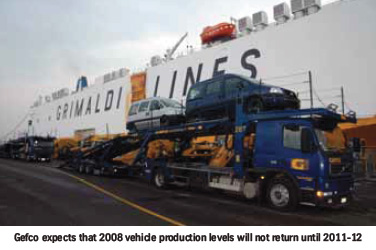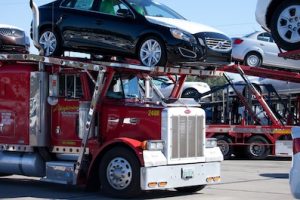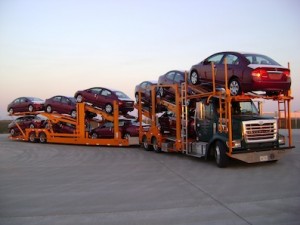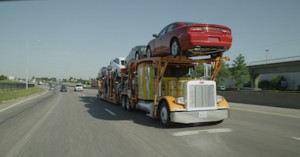
Given the high costs in purchasing and running fleets, it is vital that car hauliers consider their options carefully when buying power units. We speak to the buyers to find out what they want
Although logistics purchasing is often discussed in terms of a manufacturer’s annual spend on transport-related services, logistics providers have their own purchasing budgets to manage. New tractor-trailers easily cost $260,000-$300,000 in the US and Europe. But while that’s a lot of money to start, particularly where financing might still be constrained, car hauliers say that over the life of a truck and a logistics service, it is not even the biggest cost. Driver and fuel costs account for up to 70% of costs, according to one major European provider.
But the purchase of the power unit still has a big influence on costs over the life of a trucking operation, impacting everything from fuel efficiency, pulling power to even driver behaviour. Logistics providers must take all of this into account when buying trucks, along with a truck brand’s reliability and aftermarket service. However, given the niche status of vehicle logistics – even in a good year just a few thousand trucks are typically sold – hauliers can't always be sure that a manufacturer is keeping their business needs in mind.
Those truck manufacturers that do might offer design features or customised specifications to accommodate greater load factors, as well as on-board equipment. They might also take a life-cycle approach to servicing and maintaining a truck, considering that some carriers try to keep vehicles for up to 20 years. Perhaps equally important, ordering from such brands would mean as short as possible order-to-delivery lead times.
The new vehicle market remains the main factor in fleet purchasing – with the US haulier industry investing at least modestly in new equipment, while much of Europe tries to hold onto equipment longer – but carriers clearly have wish lists for their fleet purchases. And it seems that some truck manufacturers are fulfilling those wishes more than others.
Checking the spec list
US-carrier Proficient Auto Transport has just increased its fleet of car-haul transporters by 15%, according to president and chief executive officer Kirk Williams. After a recent review of truck options, Williams's procurement team identified three potential suppliers for its most recent order: Peterbilt (a division of Paccar), Volvo and Western Star (a subsidiary of Daimler Trucks).
“We put together a spec sheet on what we wanted each power unit to have and sent it to each OEM for their review and proposal,” says Williams. This included an electric power take-off and a battery-operated, auxiliary-power unit on every truck, not only to meet Environmental Protection Agency anti-idling requirements, but also to save fuel.
“We were interested in where and how the OEMs would install these devices, especially the batteries, since space is critical and weight an even bigger factor. This latter element is key, since it impacts on fuel economy – and the cost of fuel is our company's single largest expense,” stresses Williams.
Since the majority of the company's fleet already consisted of Peterbilt units, it made sense to stick with this manufacturer. However, Proficient also needed a tractor with strong pulling capability when handling heavy loads in mountains or hills. Williams says that it is important to plan fleet purchases around the type of vehicles to be hauled, whether the terrain will be flat or hilly and the length of the haul itself. Loading efficiency is also critical.
“A seven or eight car trailer with a high mount fifth wheel can be pulled by virtually any class eight tractor,” says Williams, referring to trucks classed above 33,000 pounds (15,000 kilos). “But only a few primary tractor manufacturers have equipment that is suitable – or can be modified to be so - for use with nine, ten or eleven car configurations, utilising a stinger fifth wheel.”
He adds that no truck manufacturer Proficient is aware of currently builds or cuts down tractors to the height needed for an adequate headrack that would allow a vehicle carried above the cab. Therefore, the tractor cab specification may have to be altered post-factory so that a rack can be fitted above it.
 Proficient Auto has recently ordered Peterbuilt trucks, thanks in part to a short order-to-delivery time
Proficient Auto has recently ordered Peterbuilt trucks, thanks in part to a short order-to-delivery timeUltimately, Proficient narrowed its buying choices down to either Peterbilt or Volvo – but Peterbilt’s shorter lead times and fewer post-manufacture requirements won the day.
“We loved the Volvo tractors' automatic drives and they also had slightly better fuel economy, but the delivery time was way too long, plus the tractors needed modifications, whereas the Peterbilt units did not. Furthermore, Peterbilt was able to start production in a matter of weeks rather than months, so we went with them,” says Williams.
Working with the OEMs who get the niche
At Jack Cooper Holdings, one of the largest American carriers and the one with the biggest planned fleet expansion according to a survey in last issue’s Finished Vehicle Logistics, chairman Mike Riggs notes cost and fuel efficiency are the two most significant factors influencing the purchase decision. Cab height is also important, because in many parts of the US operators are legally limited to a 13-and-a-half foot (4.1 metres) overall height limit. “And load factor is our single biggest determinant of profitability, making cab height and overall weight of the truck as two of our most important selection criteria,” he says.
 Jack Cooper's Mike Riggs says that in the US, 1,000-2,000 trucks are bought each year for the car haulier fleet
Jack Cooper's Mike Riggs says that in the US, 1,000-2,000 trucks are bought each year for the car haulier fleet He points out that, even in a good year, the entire car haul industry in the US only buys 1,000-2,000 trucks, making it a small volume niche market. “As a result, we prefer to work with OEMs who specialise in smaller niche markets, since they are a better match for us,” says Riggs.
Brent Larsen, CEO of the Auto Transport Group (ATG), says it is the overall cost of the tractor that determines the final decision to purchase. Other factors that should also be taken into account are engines, drivetrain options, resale values, bumper-to-back-of-cab length, the overall cab height, what cab modifications are needed and any maintenance history ATG already has with a particular brand.
“Some manufacturers do appreciate the needs of the auto-haul market and, to some extent, tailor their products towards our needs, but the selection on offer is, however, limited, given the niche aspect of this business,” admits Larsen.
When US carrier JMN Logistics considers purchasing new tractors to move its car carriers it puts fuel efficiency at the top of the list, along with cost and, crucially, resale value, says chief operating officer Cindy Darnell. One reason for the latter is that JMN tends to refresh its fleet more often compared to some other carriers, buying new trucks rather than carrying out refurbishments.
“In addition, we definitely look at whole life cost with every new purchase, with most manufacturers being able to supply this information. However, it is our past working experience with each of these [OEMs] that has the largest bearing,” she says.
Targeting the 70%
In Europe, besides a growing UK market, there may not be much new fleet purchasing given poor vehicle sales. But here the considerations for fleet efficiency are arguably even more vital, considering higher fuel and running costs than in other regions. Gefco’s UK division points out that it is important to balance between outsourced equipment and the company’s own resources. This obviously has an impact when selecting equipment based on the value it can deliver for customers, says finished vehicle logistics director, Bertrand de Techtermann.
“Even once the purchase cost, fuel efficiency and other factors are taken into account, the ‘material’ outlay only represents 30% of the total transport cost. The other 70% is shared between the driver and the fuel,” says De Techtermann.
Reducing as much from that 70% of cost should therefore be a big consideration in making fleet decisions. De Techtermann points out that there is a relationship between truck and driver costs. For example, more expensive trucks might be more fuel-efficient only when driven well. For some logistics providers, this could be worth the extra investment in training drivers in fuel-efficient driving techniques. Furthermore, on-board telematics systems can capture data on driving styles and be used to focus driving technique improvements.
"Even once the purchase cost, fuel efficiency and other factors are taken into account, the ‘material’ outlay only represents 30% of the total transport cost. The other 70% is shared between the driver and the fuel." - Bertrand de Techtermann, Gefco UK
Another important consideration in the purchase decision is production lead times, according to De Techtermann. Different manufacturers will have variable lead times depending upon market activity, with delivery time paramount to outbound service to some logistics providers. The longer that a company has to wait for its truck, the bigger the potential impact on its revenue and fleet efficiency – so shorter lead times often win out even over some differences in product costs. “In the case of car transporters, the manufacturer model specifications to meet body and trailer configurations would also be a key factor,” he says.
-Fuel efficiency
-Low cab height
-Low weight
-Configuration for 10-11 cars
-Fewer post-manufacture modifications
-Short production lead times
-High resale value
-Proximity of service network
-Strong pulling capability
-Electric power take-off
-Battery-operated, auxiliary-power unit
-On-board telematics
-Tyre durability
Measuring life-cycle costs
Proficient’s Williams says that the entire life of a vehicle should factor into purchasing decisions as well. However, he points out that without actual historic experience with each brand and real data from a manufacturer’s own current applications, trying to determine accurate future costs becomes difficult. Nevertheless, he points out that, after six months of operations with its new 2013 Peterbilt model trucks, Proficient was actually obtaining equal or even better results than the truckmaker initially suggested that the vehicles would.
Mike Riggs at Jack Cooper notes that there are currently only a handful of choices for companies looking for car haul-specific trucks in the US, while many of those products have had to remain in service for around 20 years.
“As a result, we have to look at historical performance when assessing life-cycle costs. Unfortunately, there have also been many engineering and emissions-related changes over the last decade that we usually have to assume that whatever information truck manufacturers give us about these is accurate,” says Riggs.
 Mike Riggs says it is important to consider total life costs of vehicles, although the information from OEMs is not always reliable
Mike Riggs says it is important to consider total life costs of vehicles, although the information from OEMs is not always reliableBrent Larsen of ATG agrees. “We also look at the whole life cost of the tractors, although it is not always easy to compare these between the various manufacturers. However, information provided by them, to a certain degree, is borne out by operations.”
As far as Gefco is concerned, the total cost of the purchase goes further than the actual purchase cost of the tractor. “In order for us to offer maximum value to our customers, it is vital that we take into account other considerations when making a purchase decision,” says De Techtermann. “Tyres are one area, where tyre life and durability are more important than initial purchase price and a premium-brand purchase can make a real life cost difference.”
The importance of service part networks
In terms of aftermarket and service parts support, Kirk Williams says that no two dealers or workshops are ever alike, with speed and quality of service often varying dramatically.
“Proficient is large enough to be one of the top customers in our local area, but outside this we do not have that much clout,” he admits. “As a result, we try and do most of our maintenance work in house. However, when we deal with a warranty item, we are mostly at the mercy of the dealer's repair facility.”
Fortunately, stresses Williams, the quality of tractors today is better than ever, so the frequency of warranty repairs is minimal compared to what it once was. The speed at which they get the truck into the shop and repaired has also greatly improved.
“Nowadays, we have a mix of new, nearly new and old trucks, but all maintained at the highest standards,” says Williams. “Nevertheless, outsourcing maintenance work is very expensive, particularly when it relates to projects with a heavy labour component. Even heavily discounted outside maintenance labour costs are more than double those of in-house work. We therefore scrutinise every outside repair.”
 JMN Logistics considers the re-sale value of tractors very carefully in purchasing decisions
JMN Logistics considers the re-sale value of tractors very carefully in purchasing decisionsMike Riggs at Jack Cooper characterises the aftersales service programmes offered by OEMs as being generally “very good” and having “real merit”. “They are important and we do look into them when buying trucks,” he says.
Since maintenance is a large cost factor, JMN Logistics also looks at a manufacturer's aftermarket support closely. Some manufacturers, notes Darnell, are more reasonable than others and offer higher service levels, especially when it comes to turnaround times.
“A huge consideration is where their service centres are located in respect of our network pattern,” she adds. “But, above all, when we buy a tractor, we are looking at the reputation and reliability of the manufacturer.”
"Outsourcing maintenance work is very expensive, particularly when it relates to projects with a heavy labour component. Even heavily discounted outside maintenance labour costs are more than double those of in-house work. We therefore scrutinise every outside repair." - Kirk Williams, Proficient Auto
For Gefco, aftermarket support is also crucial, since an efficient logistics provider will rarely have the in-house expertise to provide high-quality reactive technical support for its own fleet. “Additionally, the flexibility offered by the servicing agent for out-of-hours and weekend maintenance and servicing can be a factor,” suggests Techtermann.
Fleet renewals and refurbs
Today, the Proficient fleet consists of Peterbilt, Volvo, International (part of Navistar) and Sterling (also part of Daimler), although the vast majority of the power units are Peterbilt tractors.
Williams says that the company plans to stay with Peterbilt and Volvo for new power units, as Proficient has adopted a policy of narrowing down its fleet to just one or two vendors. The focus not only helps simplify servicing and purchasing, but Williams says that it is important to work with OEMs that tailor products more towards the auto-haul sector than others.
“This market is a very small niche and, as long as our industry continues to hang onto trucks for up to 15 years, it will continue to remain so,” stresses Williams. “It is so small, no OEM is going to spend a lot of valuable engineering talent to tailor too much towards it, although, in my opinion, Volvo has stepped up the plate in recent years more than any other OEM.”
Darnell also agrees that a few leading manufactures are aggressively trying to accommodate the vehicle logistics business. “As an example, some have designed trucks able to conform to the high restrictions for the headrack,” she says.
JMN’s policy is to recycle its fleet every five years, although the current average age of its trucks is closer to six years, but with replacements on order. JMN mostly operates trucks from Sterling and Peterbilts, as well as a few Western Stars.

According to Riggs, a mid-life rebuild for its truck fleet almost always makes more economic sense, although that assumes a quality refurbishment with high attention to all the engineering and other details. “An excellent refurbishment is how we can make them last 20 years in our industry,” says Riggs.
Clearly, there is no single factor that will make a truck manufacturer stand out for the car haulier sector. Higher fuel and poorer servicing might undo cheaper product costs. Likewise, the higher price tag for the latest technology and most comprehensive warranty might not amortise in time, particularly given the low margins in the sector. However, truck manufacturers would do well to pay attention to the sector’s needs. The Finished Vehicle Logistics survey found that a sample of car hauliers in the US would expand their fleet by 10-15% in 2013 alone. The European recovery, when it comes, will also fuel demand, while emerging markets have obvious potential. It might be a niche, but it’s a growing one.
Downloads
JMN logistics
ImageJMN logistics2
Image

























![Global[1]](https://d3n5uof8vony13.cloudfront.net/Pictures/web/a/d/s/global1_726550.svgz)









